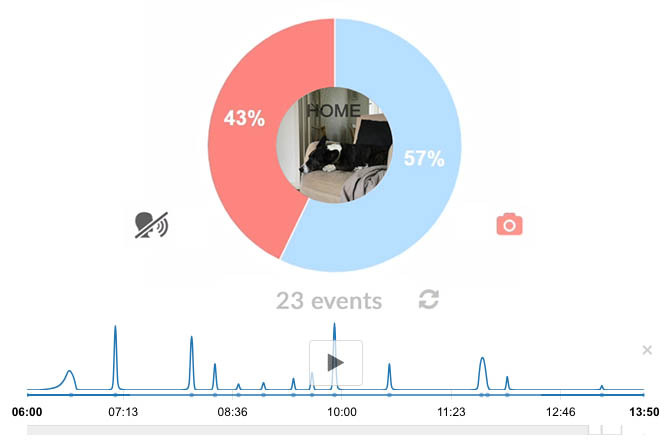Over thousands of years, dogs have evolved from independent animals to loyal companions, preferring to stay close to their human friends. Depending on the breed and individual, a dog's domestication history may not necessarily support long periods of being alone. Since being alone can be challenging for some dogs even in the best circumstances, their ability to cope with solitude is influenced by their mental resilience. This capacity for mental recovery is also known as resilience. The more a dog is prone to problems with being alone, the better its stress tolerance needs to be for the dog to cope well with solitude.

Stress tolerance is lowered by factors such as punishment-based training methods, repeated fearful experiences (like weekly forced nail trimming or fears related to encountering other dogs), limited opportunities for species-typical behavior (such as running freely and eating food with enrichment to fulfill behavioral needs like chewing and tearing), as well as chronic environmental stress, such as living in an overly busy environment.
While stress tolerance is partly genetic, the environment can significantly impact it. A good starting point is keeping a diary. Note how often your dog experiences joy in its daily life and how often it encounters disappointments or fearful states. This practice also helps you recognize your dog's different emotional states, which are often overlooked in everyday life. Increasing joyful experiences and reducing fears and disappointments helps your dog become more balanced over a few weeks. It's important to maintain these positive changes in the dog's future routine.
Current knowledge suggests that alone time training should be based on rest. In an effective exercise, the dog should be able to rest throughout the entire alone time practice. Resting is natural for a healthy, well-balanced dog, and nervous system relaxation increases up to a certain point (essentially until the dog's need for rest is fulfilled). While resting itself doesn't require stress tolerance from the dog, the animal should be gradually desensitized to resting in the absence of humans.
Teaching a Rest Routine Promotes Relaxation
A dog's ability to be alone should be founded on rest. Through this skill, being alone requires less constant stress tolerance from the dog compared to a dog left wondering what to do when alone at home. When alone time is spent resting, the dog requires less mental resilience, as resting alone is not as taxing as being alone without rest.
Teaching alone time from a perspective other than rest can often be extremely challenging or even impossible. During alone time, a dog is most likely to engage in the behavior it has repeated the most, so in practicing the rest routine, the aim is to first achieve repeated relaxed experiences. Recognizable cues synchronized with rest are used as aids. Just as keys, shoes, and a coat signal the beginning of a distressing experience for a dog with separation anxiety, recognizable, rest-predicting cues should be established for the dog's new rest skill. Consider what elements your dog could recognize as the start of its rest period.
Many dog owners use specific music and, for example, move the dog's bed to a designated training area. Installing a dog gate can also serve as a signal for practice. Some dogs start training on the same side of the gate with their owner - otherwise, they can't rest. Other dogs practice with the owner already on the other side of the gate. Choosing an individual training level is indeed the foundation of the entire rest routine training.
In teaching the rest routine, training frameworks are repeated along with rest periods daily or 1-2 times a week. The duration of the exercise is typically about 10 minutes, depending on the dog, making it easy to fit into everyday life. After this, the next suitable difficulty level for the dog is chosen. The training level is always individual. However, the most crucial aspect is to start practicing the rest routine in a way that ensures the dog remains in its comfort zone during training. Otherwise, the dog's mental recovery from exercises may weaken, and over time, even a well-progressing training cycle can break down, potentially causing the problem to resurface in its old or new form.

Pausing Alone Times
Repeating frightening alone times is extremely stressful for a dog, and no living being's mental resilience can be expected to withstand such experiences indefinitely. It is now known that a dog's alone times must be paused to enable training if the dog experiences fear or anxiety during these periods. For many dog owners, this information initially comes as a shock: how can everyday life be arranged to make training possible? At the beginning of training, it's worth putting effort especially into enabling a manageable daily routine, so that there's no rush to end the training and the work can be done calmly alongside daily life. Care options include familiar people and relatives, dog hotels and dog daycares, but increasingly, people are also finding options among their neighbors or in local Facebook groups. Sometimes owners of dogs with separation anxiety even exchange care help reciprocally.
Pausing alone times can be initially challenging, but it's necessary. Teaching two conflicting concepts simultaneously doesn't work; that is, both that being alone is safe and short-term, but at the same time sometimes too long-lasting and frightening. The prerequisite for successful alone time training is to repeat successful alone times and reduce distressing experiences to zero. In the long term, experiences of fear can make the dog ill and change its physiology and brain function, potentially permanently. The experience can be compared to a human being in mortal danger in a burning house daily. Mental recovery slows down progressively, and over time, recovery may require months before the dog's well-being begins to return to roughly its original level. If the dog's physiology has had time to adapt, for example, in the form of a recurring stress cycle or trauma, returning behavior to a state of flexibility in terms of tolerating even small stresses can take a very long time or become impossible.
Everyday Well-being is the Foundation of Alone Time
Well-being is often a broad, seemingly vague theme that is frequently discussed in connection with solving various behavioral problems. Simply put, well-being encompasses not only acute vulnerability factors in everyday life but also elements that both increase and decrease pleasure. All of these affect the dog's daily ability to tolerate stress and recover from stressful experiences. Stress experiences can also come from mild anxiety during alone time, which may not necessarily be visible as barking or destructive behavior.
To prepare concrete well-being decisions, well-being can be thought of as a thermometer; on the minus side, the animal's well-being has deteriorated. At zero level, the animal gets enough sleep and food to stay in reasonable condition. However, the modern concept of well-being aims for the plus side; the pet's life should also include factors that genuinely improve the dog's well-being instead of just maintaining life. For example, when justifying the choice of dog food, attention could previously be paid only to keeping the dog alive and at a normal weight. Now we know to pay attention to things like the dog's heartburn symptoms and bowel function, as well as stimulating various taste sensations and eating habits.
Everyday well-being must be at a good level to enable resting during alone time and recovery from alone time. It's worth investing in choosing well-being changes and maintaining them carefully in the future as well.
Summary
A dog's ability to endure alone time is individual. This ability is affected not only by the dog's genetics, personality, and social needs but also by how its alone time has been structured. Relaxed alone time taught through resting requires less mental resilience after alone time than periods where the dog was awake and may have experienced even mild anxiety. The dog's everyday well-being plays a central role in enabling mental recovery, and it's worth investing in well-being issues as much as in actual training. When the goal is a dog that is well-balanced even during alone times in everyday life, it's not worth making compromises that distress the dog during training. Alone time training should focus solely on moments when the dog can relax and feels balanced.
 Deutsch
Deutsch English
English Español
Español Français
Français Italiano
Italiano 日本語
日本語 Português
Português Suomi
Suomi Svenska
Svenska





